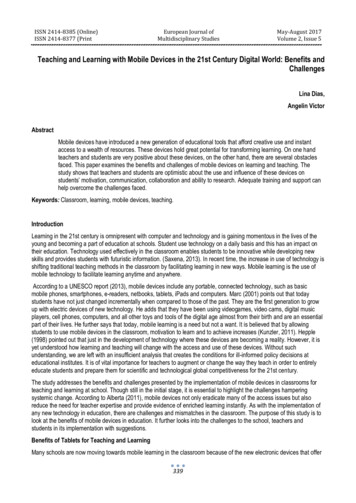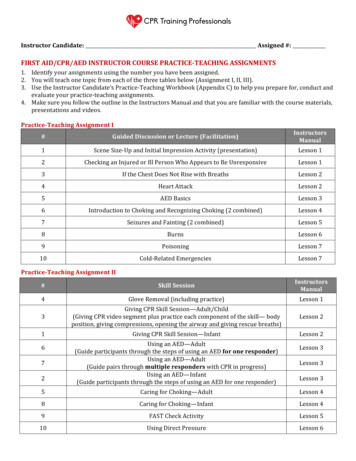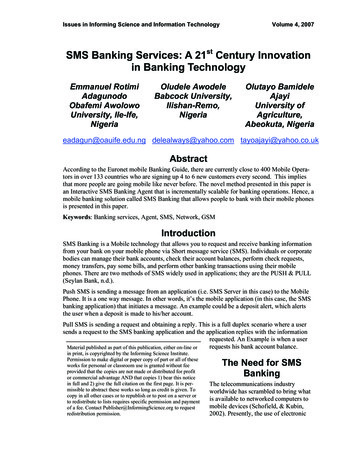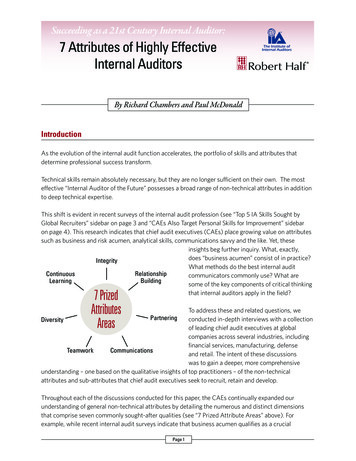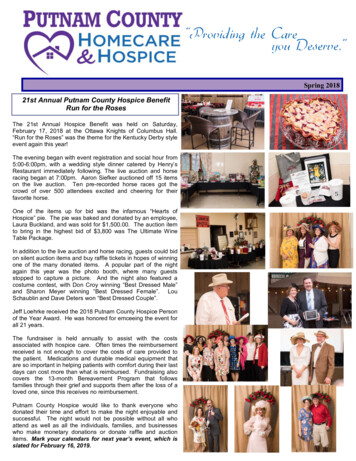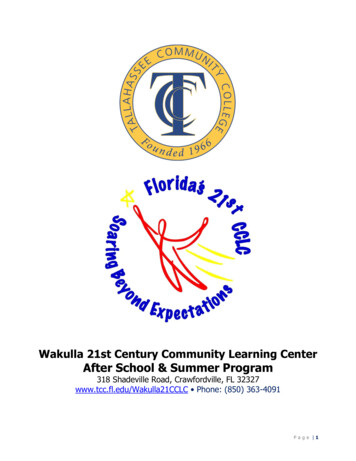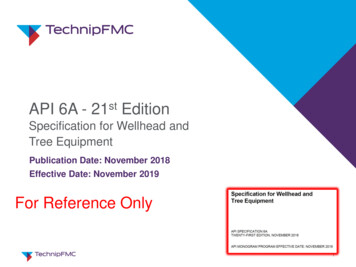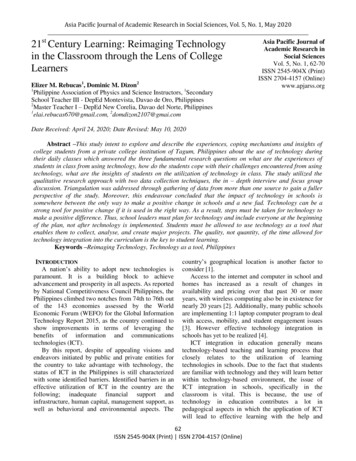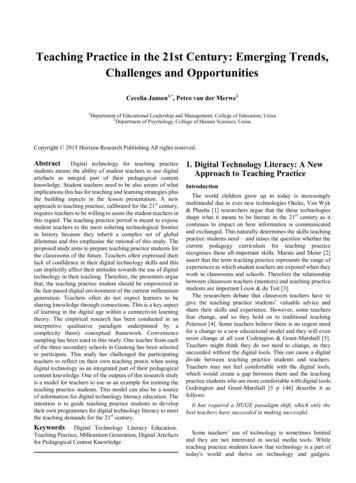
Transcription
Teaching Practice in the 21st Century: Emerging Trends,Challenges and OpportunitiesCecelia Jansen1,*, Petro van der Merwe21Department of Educational Leadership and Management, College of Education, Unisa2Department of Psychology, College of Human Sciences, UnisaCopyright 2015 Horizon Research Publishing All rights reserved.Abstract Digital technology for teaching practicestudents means the ability of student teachers to use digitalartefacts as integral part of their pedagogical contentknowledge. Student teachers need to be also aware of whatimplications this has for teaching and learning strategies plusthe building aspects in the lesson presentation. A newapproach to teaching practice, calibrated for the 21st century,requires teachers to be willing to assist the student teachers inthis regard. The teaching practice period is meant to exposestudent teachers to the most sobering technological frontierin history because they inherit a complex set of globaldilemmas and this emphasise the rational of this study. Theproposed study aims to prepare teaching practice students forthe classrooms of the future. Teachers often expressed theirlack of confidence in their digital technology skills and thiscan implicitly affect their attitudes towards the use of digitaltechnology in their teaching. Therefore, the presenters arguethat, the teaching practice student should be empowered inthe fast-paced digital environment of the current millenniumgeneration. Teachers often do not expect learners to besharing knowledge through connections. This is a key aspectof learning in the digital age within a connectivist learningtheory. The empirical research has been conducted in aninterpretive qualitative paradigm underpinned by acomplexity theory conceptual framework. Conveniencesampling has been used in this study. One teacher from eachof the three secondary schools in Gauteng has been selectedto participate. This study has challenged the participatingteachers to reflect on their own teaching praxis when usingdigital technology as an integrated part of their pedagogicalcontent knowledge. One of the outputs of this research studyis a model for teachers to use as an example for training theteaching practice students. This model can also be a sourceof information for digital technology literacy education. Theintention is to guide teaching practice students to developtheir own programmes for digital technology literacy to meetthe teaching demands for the 21st century.Keywords Digital Technology Literacy Education,Teaching Practice, Millennium Generation, Digital Artefactsfor Pedagogical Content Knowledge1. Digital Technology Literacy: A NewApproach to Teaching PracticeIntroductionThe world children grow up in today is increasinglymultimodal due to ever new technologies Okeke, Van Wyk& Phasha [1] researchers argue that the these technologiesshape what it means to be literate in the 21st century as itcontinues to impact on how information is communicatedand exchanged. This naturally determines the skills teachingpractice students need – and raises the question whether thecurrent pedagogy curriculum for teaching practicerecognises these all-important skills. Marais and Meier [2]assert that the term teaching practice represents the range ofexperiences to which student teachers are exposed when theywork in classrooms and schools. Therefore the relationshipbetween classroom teachers (mentors) and teaching practicestudents are important Louw & du Toit [3].The researchers debate that classroom teachers have togive the teaching practice students’ valuable advice andshare their skills and experience. However, some teachersfear change, and so they hold on to traditional teachingPeterson [4]. Some teachers believe there is no urgent needfor a change to a new educational model and they will evenresist change at all cost Codrington & Grant-Marshall [5].Teachers might think they do not need to change, as theysucceeded without the digital tools. This can cause a digitaldivide between teaching practice students and teachers.Teachers may not feel comfortable with the digital tools,which would create a gap between them and the teachingpractice students who are more comfortable with digital tools.Godrington and Grant-Marshall [5 p 146] describe it asfollows:It has required a HUGE paradigm shift, which only thebest teachers have succeeded in making successful.Some teachers’ use of technology is sometimes limitedand they are not interested in social media tools. Whileteaching practice students know that technology is a part oftoday's world and thrive on technology and gadgets.
Although, many teaching practice students may not feel anaffinity for digital technologies and need constant guidancefrom classroom teachers, for example preparing a lesson in away where technology can be integrated in a meaningful andfunctional way.The researchers argue that the effective development ofdigital technology literacy in teaching practice trainingshould be seen as a process of professional,inter-professional and curricular development as much asteacher training and development. Williams and Wavell [6]state that providing teachers with a model for the process ofdigital technology literacy teaching may not be as helpful asallowing them to discuss, collaborate and form consensusabout the subject at teaching practice level.One benefit of the model proposed in this article is that itacknowledges that sound digital technology learning entailsrevisiting a concept repeatedly over a period of time in orderfor teaching practice students to learn and fully understandthe concept of digital artefacts as an integrated part of theirpedagogical content knowledge. The curriculum should,according to the researchers, revisit basic ideas repeatedlyand build on them, and therefore the teacher has to act as afacilitator to guide and navigate the teaching practice studentthrough a process that enables the teaching practice studentto use critical thinking in the context of new technology.With the deictic changes in information, communication,and technology, the role of teachers is changing andbecoming more important in a way that teachers have tothink about teaching practice students who are eager abouttechnology use Leu, Kinzer, Coiro, & Cammak [7]. Themain aim of this conceptual article is to explore the wayteachers; mainly those who come from low technology areascan change their methodology and content to fit with thedigital frame in teaching practice. The proposed modelincludes a dimension for teachers to once they understandthe areas of changes, teachers will encourage teachingpractice students to be more creative than they already arewith regard to digital technology literacy teaching skills.This study reminds us that digital technology literacy ismultidimensional. The nature and extent of the digitaltechnology literacy an individual needs and develops largelydepend on the purposes they use new technology for in thefirst place. The researchers argue that different social groupsmay also require different forms of digital technologyliteracy, depending on their motivations for new technologyuse and therefore teachers need to guard against a reductiveor mechanistic approach when assessing the levels of digitaltechnology literacy in teaching practice students.In relation to the teaching of new technology literacy, theresearchers use the all-encompassing term ‘digital medialiteracy’. A general definition of this term is that itincorporates the skills, knowledge, creativity and attitudeseveryone needs when using digital media for learning andmastering the knowledge society Newman [8]. This is,however, a general definition, which only to a certain extentmanages to encompass digital media literacy in schoolsettings. Therefore, the researchers have found it necessaryto include a narrower definition that more directly focuses onteaching practice teachers and digital media literacy inschool settings: Digital media literacy for in-service teachersis the ability to use digital artefacts as an integrated part oftheir pedagogical content knowledge and be aware of whatimplications this has for teaching, learning strategies andbuilding aspects. Almas & Krumsvik [9 p 480].Growing up in the digital age means that learners have aninfinite amount of information available through the internet,but it also means learning reasonable and safe behaviourwhile online Levine and Cureton [10] have stated in thenineteenths [1998] that the digital media generation is nobetter and no worse than any other generation, but, like everyother generation before, is unique. This generation isdifferent, as their times are different Codrington &Grant-Marshall [5]. Above all, today’s learners are in need ofa digital media literacy education that equips them with fourcrucial life skills: critical thinking, responsibility, anappreciation of differences, and efficacy. Rosen [11] arguesabout the fact that teachers’ fear of change is not necessarilyconnected to digital tools only, but also that teachers areworried about the neurological, social, and psychologicaleffects of learners’ overuse and misuse (including abuse) oftechnology Okeke, Van Wyk, Phasha [1]. Consequently, thisgeneration requires a unique brand of education that willenable them to realise their personal dreams and serve thesociety of which they form part.Teachers cannot afford to ignore or trivialise the complexsocial, intellectual and emotional functions of digitaltechnologies in the lives of young people Hobbs & Frost [12].In order to reach today’s learners, teachers need to beresponsive to learners’ experience with their culture —which is what they experience through television, movies,YouTube, the internet, Facebook, music and gaming. Whenteachers learn more about learners’ choices, the first ‘thing’they will notice is how different their learners are from them.When it comes to media and technology, every two yearsbrings a new set of changes in the landscape of their daily life.Even if a teacher is only a few years older than his or herlearners, there may be important differences becausetechnology tools are changing so very rapidly. That is whyteachers need to gain the latest information about the mediaand technology choices learners make at home (and at school)each day Ungar [13]. This situation highlights the need fororientation programmes in South African teaching practicetraining that adequately prepare teaching practice studentsfor the complex and dynamic teaching situation of the 21stcentury.A study on digital media literacy around the world foundthat there are eight factors that appear to be crucial to thesuccessful development of digital media literacyprogrammes in teacher training Pungente [14]. The eightfactors are: Digital media literacy programmes, like otherinnovative programmes, must be a grassrootsmovement. Teachers need to take the initiative inlobbying for its inclusion in the curriculum.
Educational authorities must give clear support to suchprogrammes by mandating the teaching of digital mediastudies within the curriculum, establishing guidelinesand resource books, ensuring that curricula aredeveloped, and making certain materials available.Faculties of education must hire staff capable oftraining future teachers in this area. There should alsobe academic support from tertiary institutions in thewriting of curricula and in sustained consultation.In-service training at school district level must be anintegral part of programme implementation.School districts need consultants who have expertise indigital media literacy and who will establishcommunication networks.Suitable textbooks and audiovisual material that arerelevant to the country and/or area must be available.A support organisation must be established for thepurposes of workshops, conferences, dissemination ofnewsletters, and developing curriculum units. Such aprofessional organisation must cut across school boardsand districts to involve a cross-section of peopleinterested in digital media literacy.There must be appropriate evaluation instrumentssuitable to the unique attributes of digital technology.Because digital media literacy education involves such adiversity of skills and expertise, there must be collaborationbetween teachers (schools), tertiary institutions (researchers)and Department of Education. Digital media literacy: a plan of actionIn this section, the theoretical and conceptual aspects ofmedia literacy education are explored in order to find aframework for a model for digital media literacy education inteaching practice training. Ultimately, the goal of digitalmedia literacy education should be to enable teachingpractice students to develop their own creative as well ascritical capacities in relation to the use of technology in theclassroom. In doing so, the researchers argue that theteachers (including the teaching practice students) willrealise that their choices are not limited to adjustingthemselves to a century determined by technology; instead,they will have the awareness, the moral and ethicalsensibilities, and the will to adjust technology to fit into their21st century teaching practices.Today’s learners engage in activities on interactivewebsites, TV programmes and other media and technologiesthat shape their literate identity Ungar [13]. Usingtechnology in the classroom, teachers are becoming activeparticipators and developers. Typical competencies have notbeen clarified by research at the time of this study, and thisshould be rectified in order to enable the development ofappropriate curricula on pedagogy. The researchers arguethat competence can no longer be restricted to individualcompetencies – it should also be defined in terms ofcollective intelligence. Teaching practice students need touse technology to share ideas, evaluate others and workcollaboratively.The researchers want to emphasise the fact that whendigital media literacy merely entails the pursuit of skills to beable to use the latest technology, then the means becomes theend. Over and above the necessary skills, digital medialiteracy must include teacher’s attitudes towards technology,as well as knowledge of the effects technology has onlearners and society as a whole.It is also important to note that the lack of software ordigital tools does not prevent teachers from changing theirpractices. In developing countries, digital tools are not assophisticated as the ones used in developed countries.However, teachers can adapt their teaching in spite of thelittle available tools. Several studies have been conducted onstudent teacher’s experience and anxieties during teachingpractice Ngidi & Sibaya [18]; Marais & Meier, 2004 [2] tomention but two.However, a review of the literature indicates that there arelimited studies that have been conducted regarding ways inwhich teachers guide teaching practice students to developtheir own lesson plans for digital media literacy to meet theteaching demands for the millennium generation. One of theexpected results or outputs of this research study is a modelfor teachers to use as an example for training the teachingpractice student.Due to the cultural diversity in South African classroomsthe model is designed to be developmentally and culturallyappropriate, is geared towards diverse learning styles, andwill engage learners whether they attend a school with onecomputer per learner or a school with no computers at all.2. Research MethodologyStudy populationOne teacher from each of the three secondary schools hasbeen selected to participate. This article focuses on teachersfrom secondary schools in general. The rationale behinddealing with teachers in general and not teachers of a specificdiscipline is to explore the way teachers in low technologyareas can see their development from a digital perspective. Itis also assumed that digital education is needed in all fieldsof education.Methodology approachA qualitative research approach has been used in the studywhich was conducted at different public schools in theGauteng region.AimThe main objective of this research study can therefore bedefined as follows: To address the practical process ofproviding a quality digital media literacy programme that isintegrated with the school curriculum to challenge theparticipating teachers to reflect on their own teachingpractice to use digital media literacy as an integral part oftheir pedagogical content knowledge.
The proposed digital media literacy programme in thisstudy also aims to prepare teaching practice students teachersfor the classrooms of the future. Sime and Priestley [19] havenoted that teachers often expressed their lack of confidencein their digital technology skills and that this can implicitlyaffect their attitudes towards the use of digital media literacyin their teaching.Research designThe empirical research has been conducted in aninterpretive qualitative paradigm underpinned by acomplexity theory conceptual framework. In this study, asample of the teachers’ use of digital media literacy lessonsis the area of interest. The context is South Africansecondary schools (see study population above).The data are gathered over a period of six weeks duringthe time period of 2013 by means of semi-structuredevaluation questionnaires to teachers. Individual interviewsand group interviews, and verbalisations were also made useof. This study evaluates the proposed digital media literacyprogramme’s ability to effect improvements in the followingobjectives for teachers: Critical-thinking skills; Communicating skills; Information-seeking strategies; Goal-setting/future aspirations; Decision-making/social skills; Sharing; Exchanging; Creating; and Digital media literacy.The main research questionHow do teachers in secondary schools make use of theproposed digital media literacy model for teaching andlearning?Variables of interest for the main research questioninclude the purpose (accessing information, recording,processing information, lesson planning, activities,communicating), type of learning activity, and the type ofdigital media literacy outcome used.Sub-research questions What factors impede or encourage the implementationof the digital media literacy model by teachers?How do teachers in secondary schools connect andcollaborate in their teaching of digital media literacy?What is the potential learning and the actual learningthat occurs in a teacher’s classroom as learners engagein digital media literacy activities ?The variables of interest for these sub-questions includeengagement levels, creativity, conceptual understanding,critical thinking, reflection, and connections.The research questions do not exist in isolation. A logicmodel (figure 1) has guided the data gathering and analysisand the four research questions were embedded in the logicmodel. They are connected, and through the connections agreater understanding of teaching digital media literacy inthe digital age will be constructed.Constructivist, complexity and connectivist theoriesunderpin the logic model in figure 1.Figure 1. Logic model causal map to guide research
Constructivist learning theoryDewey [15] believes education must engage with andexpand experience; those methods used to educate mustprovide for exploration, thinking and reflection, and thatinteraction with the environment is necessary for learning.Dewey [15] therefore advocates the learning process ofexperimental learning through real-life experience toconstruct and conditionalise knowledge, which is consistentwith the constructivist learning theory.This research looks at the constructivist role of teachers tosupport learners in becoming effective thinkers. In theconstructivist classroom, the teacher’s role is to prompt andfacilitate discussion. The learning environment should alsobe designed to support and challenge the learners’ thinking.It appears that a focus on learning through practical activityhas been categorised as construc
Teaching Practice in the 21st Century: Emerging Trends, Challenges and Opportunities . Cecelia Jansen. 1,*, Petro van der Merwe. 2. 1. Department of Educational Leadership and Management , College of Education Unisa
